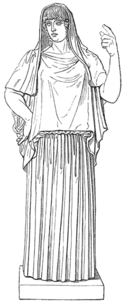Consentes Dii
Consentes Dii (z łac. consentes „wspólnie istniejący”[1]) – w mitologii rzymskiej dwanaście głównych bóstw, odpowiednik greckiego Olimpu.
Początkowo, w religii etruskiej, było to grono 6 bogów i 6 bogiń, stanowiących radę przyboczną Jowisza[2]. W późniejszym okresie Rzymianie zapożyczyli od Etrusków ową wiarę w 12 bóstw, utożsamiając je z poszczególnymi bogami panteonu greckiego[2]:
- Jowisz (grecki Zeus)
- Junona (grecka Hera)
- Neptun (grecki Posejdon)
- Minerwa (grecka Atena)
- Mars (grecki Ares)
- Wenus (grecka Afrodyta)
- Apollo
- Diana (grecka Artemida)
- Wulkan (grecki Hefajstos)
- Westa (grecka Hestia)
- Merkury (grecki Hermes)
- Cerera (grecka Demeter)
Dwunastu bóstwom poświęcony był portyk prowadzący z Forum Romanum na Kapitol[1], w którym wystawione były przedstawiające je posągi[2].
Galeria
Przypisy
Media użyte na tej stronie
Athena of the Giustiniani type. Marble, Roman copy after a Greek original of the late 5th century BCE.
Autor: Didier Descouens, Licencja: CC BY-SA 4.0
Fontana del Nettuno The Fountain of Neptune (1563-1566), Piazza Maggiore in Bologna by Giambologna
Autor: Stuart Yeates, Licencja: CC BY-SA 2.0
Adonis Centocelle (Apollo probably with bow and arrow), mid-2nd century AD) - This statue is in the Ashmolean Museum, part of the University of Oxford. As of Jan 2006, it could be found in the gallery immediately on your left as you pass through the main entrance.
Label at https://flickr.com/photos/stuartyeates/54900779/
Autor: unknown, Licencja: CC BY 2.5
Demeter. Coarse-grained marble, Roman artwork; the head is a modern restoration.
Autor:
Statue of the type of the Capitoline Venus. Marble, Roman copy of ca. 100-150 CE after a Hellenistic variant of the Cnidian Venus. Excavated in 1794 by Robert Fagan at Campo Iemini, near Torvaianica, Lazio, Italy.
The Campana Hera, a 2nd century Roman copy of a Hellenistic original. Louvre, Paris
Autor: Copy of Lysippos?, Licencja: CC BY-SA 3.0
Youth untying his sandal, so-called “Sandalbinder Hermes”. Left arm and shoulder, right forearm and thigh, part of the chlamys and the plinth are modern restorations; the ploughshare at the base of the rock is a modern addition based on an errouneous identification with L. Quinctius Cincinnatus; the head is ancient but may be nonpertinent to the statue. Pentelic marble (body), Roman copy of the 2nd century CE after a Greek original of the late 4th century BC. From the Theater of Marcellus in Rome.
Vesta Giustiniani oder Giustinianische Vesta (Hestia) im Museo Torlonia in Rom, eine weibliche Gewandstatue strengen Stils.
Vulcan. Marble, reception piece for the French Royal Academy, 1742.





















